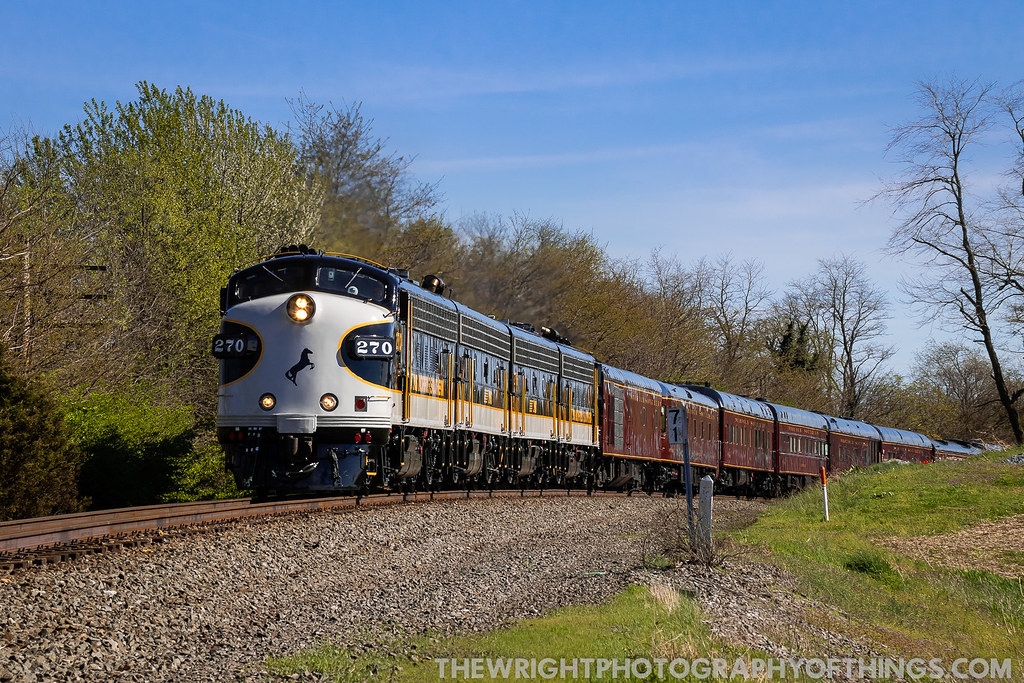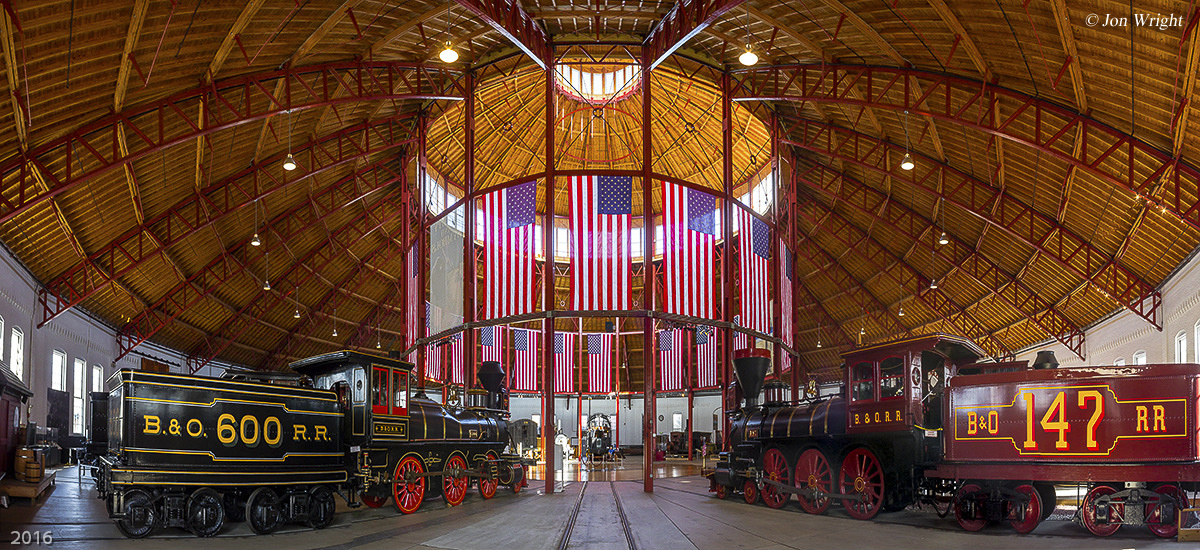Maryland Scenic Train Rides: A Complete Guide
Last revised: February 22, 2025
By: Adam Burns
Maryland enjoys a rich railroad heritage. It is home to America's first common-carrier, the Baltimore & Ohio, and was also served by the Pennsylvania Railroad's "Northeast Corridor," Western Maryland Railway, Norfolk & Western, Reading, and perhaps the most famous of all short lines, the Maryland & Pennsylvania.
In addition, Washington, D.C. was located right next door where lines of several southern carriers met those of the Northeast/Midwest. Today, several tourist rides are available in the Old Line State, along with many museums.
These include, among others, the B&O's former Mount Clare Shops (now home to the Baltimore & Ohio Railroad Museum) and the popular Western Maryland Scenic Railroad.
Please note! The guide information here pertains only to Maryland scenic train rides related to vacation and tourism destinations. If you are interested in intercity/long distance rail travel please visit Amtrak's website.
 Norfolk Southern's former F units lead the company's "Office Car Special" just north of Hagerstown, Maryland on May 5, 2019. The train was on its way to "The Masters" tournament that year. Jon Wright photo.
Norfolk Southern's former F units lead the company's "Office Car Special" just north of Hagerstown, Maryland on May 5, 2019. The train was on its way to "The Masters" tournament that year. Jon Wright photo.State Rail History
Many reading this are likely at least vaguely familiar with Maryland's first railroad, the fabled Baltimore & Ohio.
The B&O was created predominantly to provide Baltimore with an efficient transportation system which could compete against the mighty Erie Canal, the famous (and expensive) all-water artery linking New York City with the Port of Albany (Buffalo).
In addition, Philadelphia was planning a similar transportation system to connect with Pittsburgh. The Baltimore & Ohio Railroad was chartered on February 28, 1827 and officially incorporated and organized on April 24, 1827.
By July 4th construction began when a cornerstone was laid in the city.
According to the book, "Baltimore & Ohio Railroad," by Kirk Reynolds and David Oroszi it was tradition to launch new canal construction on July 4th and since the B&O was a similar endeavor, Independence Day was chosen.
In January of 1830 the B&O launched service over its first 1.5 miles from a small station in Baltimore at Pratt Street. Only months later, 13 miles was opened to Ellicotts Mills (today Ellicott City).
In 1852 the company completed its charter by reaching the Ohio River at Wheeling, Virginia (West Virginia after June 20, 1863).
 Inside the Baltimore & Ohio Railroad Museum's restored Mt. Clare Roundhouse completed in 1884 and designed by E. Francis Baldwin. Jon Wright photo.
Inside the Baltimore & Ohio Railroad Museum's restored Mt. Clare Roundhouse completed in 1884 and designed by E. Francis Baldwin. Jon Wright photo.At its peak the B&O, consisting over 10,000 miles, and served every major city between Chicago and New York (the latter was via ferry service only).
According to John Stover's book "The Routledge Historical Atlas Of The American Railroads," mileage in Maryland peaked at nearly 1,500 during the 1920's.
Today, the Association of American Railroads lists 937 miles in operation, served by ten different railroads. As mentioned above, if there is one tourist train you are planning to ride in the state, a visit to the Western Maryland Scenic is highly recommended.
Their 12 miles cuts through the beautiful Appalachian Mountains and passes along famed Helmstetter's Curve, across the "Bridge Through The Narrows," and through Brush Tunnel.
Aside from the WMSR there is the Walkersville Southern Railroad located in Walkersville, as well as two streetcar/trolley museums; the National Capital Museum (located in Washington, D.C.) and Baltimore Streetcar Museum.
Both the WMSR and Walkersville Southern host special events throughout the year so be on the lookout for those!
Overview
Baltimore & Ohio Railroad Museum
The Baltimore and Ohio Railroad Museum is one of the most widely recognized, respected and highly regarded such institutions throughout the world.
It was launched by the Baltimore & Ohio itself and, not surprisingly, many of the pieces are of B&O heritage.
The are numerous examples within their collection that predate the Civil War, all thanks to the railroad's efforts to recognize its history at an early date.
The museum also contains pieces from other railroads but predominantly focuses on the B&O, Western Maryland, and Chesapeake & Ohio.
Much of this equipment is housed within the B&O’s famous Mount Clare Shops (over the years this location out-shopped or overhauled thousands of steam and diesel locomotives as well as many cars, such as the famed "Wagontops").
Among their other attractions the museum features two scales of large model railroads in G and HO as well as layouts brought in annually by various modeling groups. Along with its extensive collection the organization offers short scenic train rides (about a mile or so) on its property.
Baltimore Streetcar Museum
The Baltimore Streetcar Museum's mission is to preserve the city's interurban heritage. In doing so it also offers short trolley rides aboard some of its restored equipment.
It was originally founded in 1966 by members of the Baltimore Chapter/National Railroad Historical Society and is open throughout much of the year.
The city of Baltimore was served by one notable interurban, the Washington, Baltimore & Annapolis Electric Railway. As Dr. George Hilton and John Due's authoritative piece, "The Electric Interurban Railways In America," notes this company's heritage began in 1898 when a project was launched to link Baltimore and Washington, D.C. with an electrified railroad.
It was opened on April 3, 1908 with a branch to Annapolis. It grew over the years by adding two nearby systems; the Annapolis Short Line in 1921 (Baltimore-Annapolis) and the Annapolis, Baltimore & Washington (Annapolis Junction - Annapolis).
The WB&A was one of the more successful interurbans, typically grossing more than $2.5 million annually with excellent equipment and a superb right-of-way.
However, following losses brought about the Great Depression and other transportation modes, officials elected to shutdown the transit system unexpectedly on August 20, 1935.
National Capital Trolley Museum
Like the Baltimore Streetcar Museum, the National Capital Trolley Museum aims to preserve the region's history of trolleys and interurbans, particularly around the Washington, D.C. area. Based in Colesville (somewhat north of downtown Washington) the museum operates about a 1-mile stretch of track.
In addition to running standard excursions for the general public the group also hosts charters and features other special events throughout the year.
The museum is open year-round on weekends. It was formed on January 4, 1961, as the National Capital Historical Museum of Transportation, Inc. and began construction on its current museum facility a few years later in 1965.
In 1969 they operated their first streetcars and have continued to do every year since that time. In 2009 a major update to the museum was completed when a visitors' center, a display building, and a storage-and-maintenance facility were all dedicated.
Walkersville Southern Railroad
The Walkersville Southern Railroad, based in Walkersville, operates nearly 7-miles of a former Pennsyvlania Railroad branch from Woodsboro to a point near Frederick, Maryland.
Along the way the rail line travels through the state's beautiful and historic Monocacy Valley region.
Trains board from the restored Walkersville depot (completed by the York, Hanover & Frederick, a PRR subsidiary, in 1899) and the railroad is hoping to restore more miles in the future to further extend trips.
Their locomotive fleet includes numerous switchers, several of which are operational:
- American Car & Foundry 18-ton switcher #1 (built by the Plymouth Locomotive Works in 1942)
- A 25-ton switcher (built by the Davenport Locomotive Works) given #2
- U.S. Army 45-ton switcher #45 (built by General Electric in 1943 as #7496)
- U.S. Army 40-ton switcher #101 (built by Electro-Motive in 1942 as #7954)
- U.S. Army 20-ton switcher #3 (built by Davenport in 1942 as #7707)
- A trio of 44-ton switchers all manufactured by General Electric
Western Maryland Scenic Railroad
The Western Maryland Scenic Railroad is a tourist attraction based in Cumberland that operates part of the Western Maryland Railway’s former main line to Frostburg, Maryland, a distance of 15.3 miles.
The railroad has a small fleet of diesels and for many years 2-8-0 #734 handled excursion duties. However, this locomotive has been sidelined and in need of overhaul.
The star of the show is now Chesapeake & Ohio 2-6-6-2 #1309 (painted as WM #1309), the largest Mallet currently in operation in North America.
It carries passengers through some of the Western Maryland’s most famous locations like Helmstetter’s Curve and, "The Narrows."
Today, the Consolidation is out-of-service and awaiting overhaul while a GP30, adorned in WM's "Circus" livery, powers most trips.
Overall, the tourist line has become a very popular attraction in western Maryland and offers you several different trains to ride, aside from its standard excursion to Frostburg.
The WMSR will soon be featuring a new star attraction, restored Chesapeake & Ohio 2-6-6-2 #1309 to complement #734. This gigantic compound steam locomotive will be the largest operating along the East Coast.
Contents
Recent Articles
-
Kentucky Christmas Train Rides On The "Santa Train"!
Dec 15, 25 11:10 PM
Where rail history and holiday magic meet in the heart of Kentucky’s horse country, the Bluegrass Scenic Railroad and its beloved Santa Trains offer families, railfans, and holiday enthusiasts an expe… -
Indiana Christmas Train Rides In La Porte!
Dec 15, 25 11:05 PM
Among the Hesston Steam Museum's standout events each year is the seasonal Santa’s Candy Cane Express, a holiday-themed train ride and festive morning-to-afternoon experience. -
California Christmas Train Rides In Campo!
Dec 15, 25 10:59 PM
Nestled in the Mountain Empire region of southeastern San Diego County, the Pacific Southwest Railway Museum. During the Christmas season they host the popular North Pole Limited.



